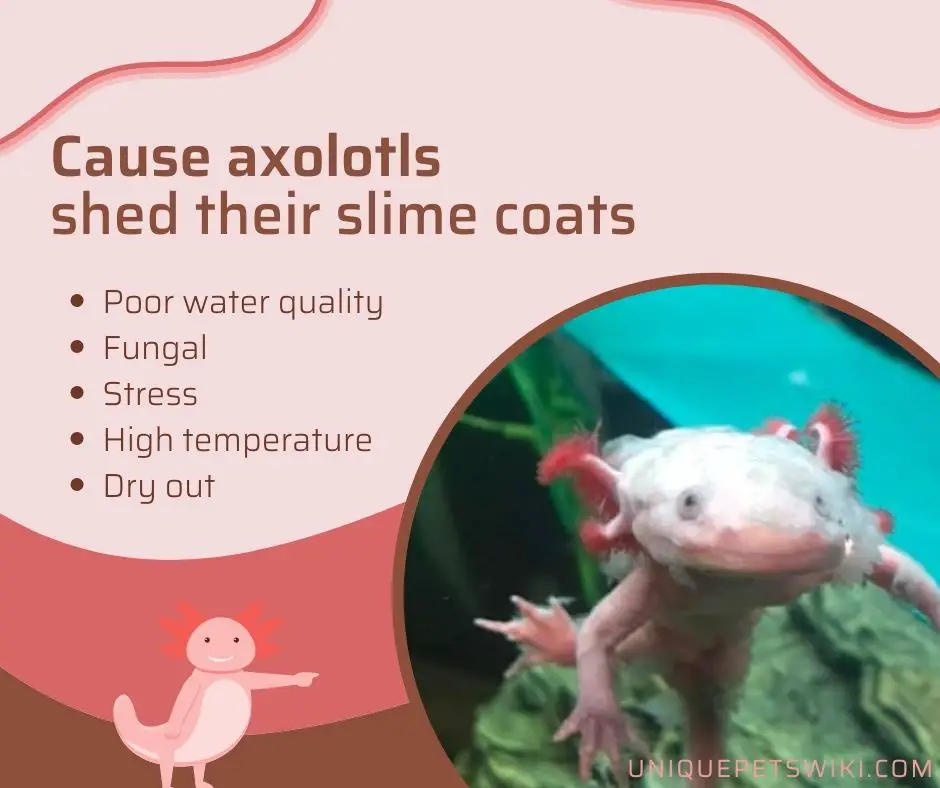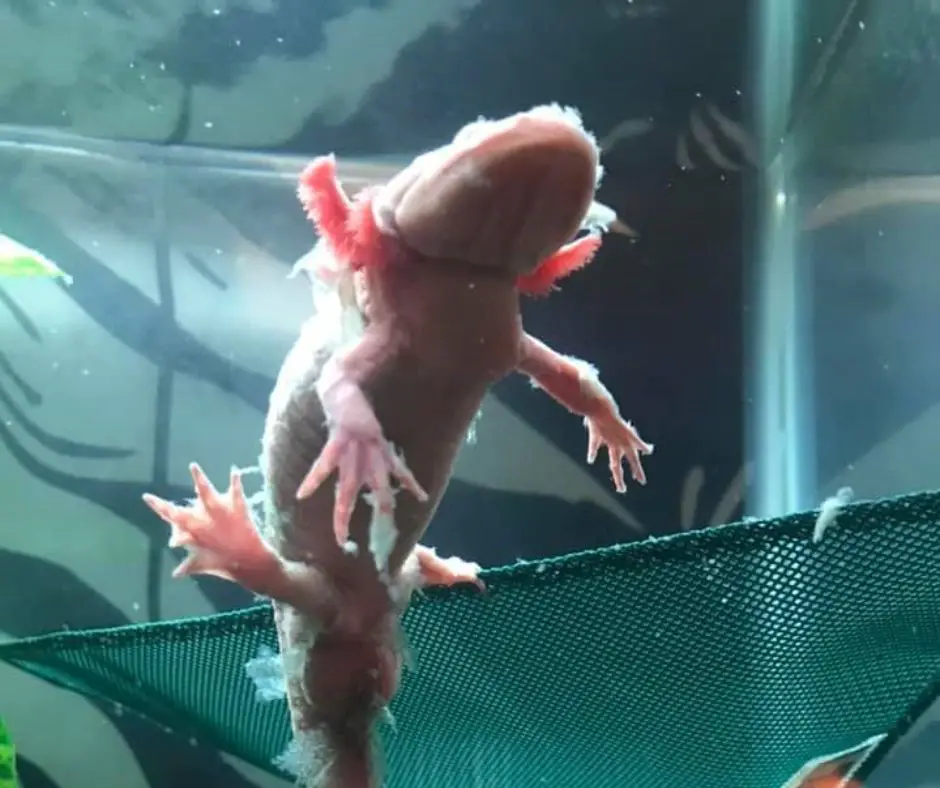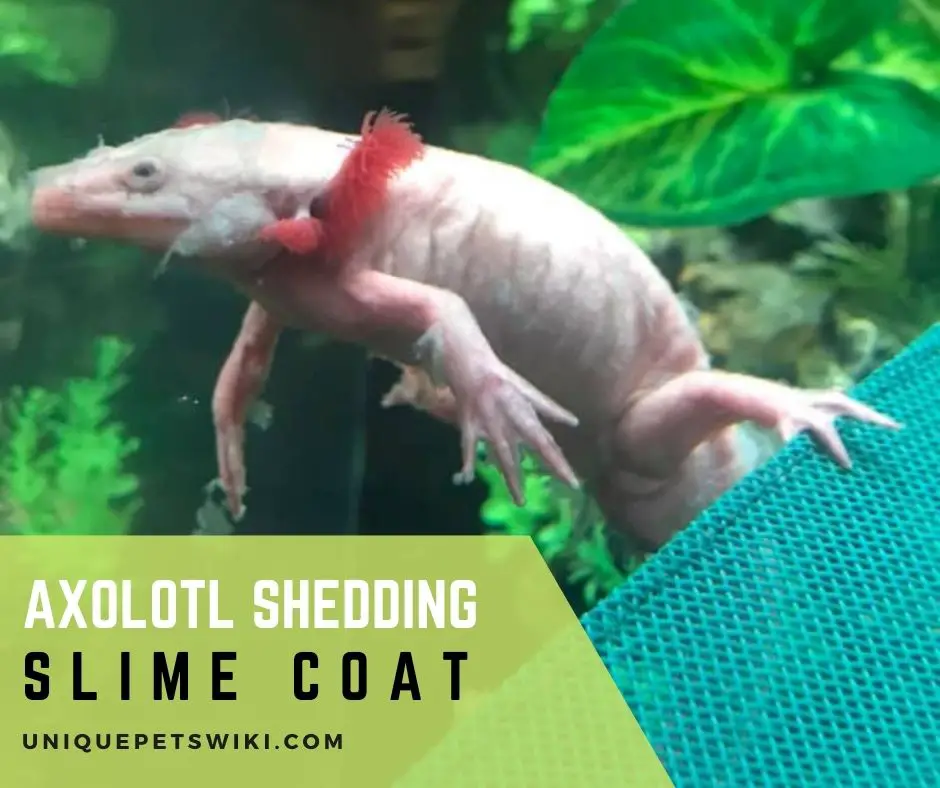Axolotls require special care, making keeping them as pets confusing to new owners. You may be worried if you notice that your axolotl is shedding slime and coat, and you can’t determine whether they are sick or what causes this.
Axolotls can shed their slime coat, but this does not occur naturally. However, they can shed if they are under stress or the water condition in their tank is not ideal. This can cause skin damage and shed out their slime coat.
This article is for you if you want to know what causes axolotl shedding and how to prevent and treat this condition. So, let’s dive in!!!
Contents
Why is Your Axolotl Slime Coat Coming Off?
The skin of an axolotl plays the same role as other animals as it helps to protect the internal organs. Axolotls also have a slime coat, a slippery substance found on their skin.
The slime coat helps protect the skin, keeps it moist, regulates its temperature, and protects the skin from fungus, bacteria, and harmful substances.
However, an axolotl slime coat can come off if something is wrong with the water condition in their tank. The slime coat will look like a white sheen on their body. Some of the reasons why axolotls shed their slime coats are stated below:

Poor Water Quality
The main reason axolotls shed their slime coat is poor water quality. Some of the water qualities that can make axolotl shed are:
Chlorine
Axolotl may shed its slime coat due to the presence of chlorine in the water. This is common if you use tap water treated with chlorine to fill their tank. The chlorine in the water usually burns the axolotl slime coat and skin, making them shed.
A great way to prevent this is when using tap water treated with chlorine put the water in a bowl and allow the water to sit for a full day. This allows the chlorine to dissipate before adding it to the tank. Another thing is to use a dechlorinating agent to remove the chloramine.
Heavy Metals
The presence of heavy metals in an axolotl’s water can also make them shed their slime coat and potentially their skin. Heavy metals not only affect axolotl’s skin, but they can also lead to organ failure and death. This is why you should ensure there are no heavy metals in your axolotl’s water.
A great way to ensure that axolotl tank water does not contain heavy metals is to use a water conditioner.
Ammonia Levels
One of the common things that most axolotl owners have to deal with is excess ammonia in the tank, which can make your axolotl shed.
However, there are cases where low ammonia levels in their water can also make your axolotl shed and may even kill them if you don’t fix it.
Excess ammonia in the axolotl tank is usually caused by uneaten food, rotting plants, and fish waste. This can also happen if you don’t use a filter or change your water regularly.
You can prevent ammonia buildup in axolotl tanks by changing their water regularly and cleaning their tank at least once a week. You should also invest in a filter that can help remove both mechanical and biological material from their tank.
Fungal
Although this is a rare occurrence, fungal infections can also make your axolotl shed. Certain fungi can attach to axolotl skin and grow on them. The fungi can then make your axolotl shed and lead to death if it is not treated.
Some of the signs that an axolotl is affected by fungi are:
- Your axolotl looks uncomfortable
- It looks skinny
- It has white salty spots
- It stops eating
It is important that you treat your axolotl immediately if you notice that it is shedding slime because of fungi infection. You can remove the fungus by giving your axolotl a tea bath.
Stress
Stress is another reason why your axolotl can shed their slime coat. Axolotls can be stressed by a wide range of bad tank mates, improper feeding, excessive handling, bad water conditions, overcrowded tanks, etc.
Once your axolotl is stressed, you will notice that it will stop eating and start shedding its coat. A great way to treat this is to determine what is causing your axolotl stress and then remove the stress factor.
For example, you can opt for a solitary tank for your axolotl or a larger tank if aggressive tank mates stress your axolotl. You should check the water quality regularly to help detect when the water condition in your axolotl changes.
High Temperature
Generally, axolotls require a cold climate to stay happy and healthy. An axolotl can become stressed and shed its slime coat if you house them in a tank with too high or too low a temperature.
Once you notice that your axolotl starts shedding, a great thing to do is check the water temperature to help ensure it is at the appropriate level. Once you notice the water temperature is too high, the best thing to do is adjust the temperature to the appropriate level (60-64F).
You may need to invest in a chiller to help ensure the temperature is at an ideal level.
IceProbe Thermoelectric Aquarium Chiller
- Unit is 4" x 4 3/4" x 7 1/2" includes probe. Cord: 5' 9", probe cord: 6'.
- Warranty: Unit has a one year warrenty agains defects in materials and workmanship.
Last update on 2022-12-30 / Affiliate links / Images from Amazon Product Advertising API
Dry Out
Although axolotls are amphibians and can survive for some hours out of the water, keeping them out of the water is not good for them. They will start to dry out and shed their slime coat. Furthermore, they can become dehydrated and can even die in extreme conditions.
You can prevent your axolotl from drying out by ensuring you don’t keep them out of the water at all times.
Do You Need to Worry if Axolotl Shedding Slime Coat
An axolotl slime coat helps protect their skin from fungus, bacteria, and other harmful substances. The slime coat also helps regulate their temperature and keep their body moist. The good thing is that axolotl can regrow their slime coat immediately after shedding it.
However, you should be concerned if your axolotl sheds a slime coat. This is because it indicates that the living condition of your axolotl is not ideal. Furthermore, this can stress out your axolotl, making them susceptible to several diseases.
Can Axolotls Die due to Shedding?

No, axolotls don’t usually die from shedding. However, your axolotl can die from the underlying causes of shedding. This is because it can stress out your axolotls, leading to health problems, and if it persists for a long time it can lead to death.
This is why you should try and determine why your axolotl is shedding immediately and try to fix it before it is too late.
You can do this by checking your water parameters and looking for signs of sickness such as lethargy, unusual behavior, lack of appetite, axolotl floating in the water, etc.
What Do You Do with an Axolotl Shedding Slime Coat?
The main reason why an axolotl shed slime coat is due to poor water quality. You can try out some of the things when your axolotl starts shedding a slime coat.
- Quarantine your axolotl in a clean tub with clean and dechlorinated water.
- Ensure the water is at an ideal level by checking the water quality.
- Add a bit of Aloe Vera into your axolotl water, as it is great for their slime coats.
Give your axolotl a tea bath in case of fungi infection.
API Water Test Kit
- Contains one (1) API FRESHWATER MASTER TEST KIT 800-Test Freshwater Aquarium Water Master Test Kit, including 7 bottles of testing solutions, 1 color card and 4 glass tubes with cap
- Helps monitor water quality and prevent invisible water problems that can be harmful to fish and cause fish loss
- Accurately monitors 5 most vital water parameters levels in freshwater aquariums: pH, high range pH, ammonia, nitrite, nitrate
- Designed for use in freshwater aquariums only
- Use for weekly monitoring and when water or fish problems appear
Last update on 2022-12-30 / Affiliate links / Images from Amazon Product Advertising API
How To Prevent Axolotl Shedding Slime Coat
Here are ways that you can use to prevent your axolotl from shedding slime coat:
- Always clean your axolotl tank once a week to remove algae, uneaten food, dead plants, and axolotl stool that can lead to ammonia buildup.
- Change your axolotl water often if you don’t have a water filter.
- Invest in a water filter to help ensure there is no ammonia spike.
- Invest in a water conditioner to help ensure the water is free from heavy metals.
- Ensure the water temperature in your axolotl tank is at the optimal range.
- Only use clean tap water free from chlorine for your axolotl tank.
- Keep an eye on your axolotl to help ensure it is not stressed.
In Short
Generally, axolotls don’t shed their skins but can shed their slime coats. However, this is not a natural occurrence as it indicates something is wrong with your axolotl or the water condition you keep them in is poor.
The best thing is that an axolotl shedding slime coat can be remedied if you can determine the underlying cause of the problem.
We would like to hear from you in the comment section below about your experience with axolotl shedding slime coats and any questions that you may have on the issue.


